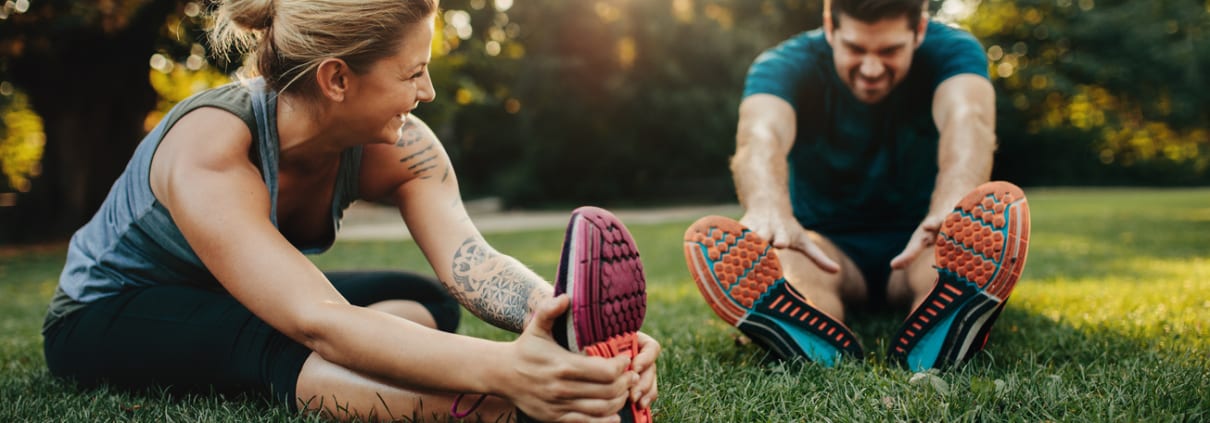Get fit for summer – with or without the gym

It’s that time of year – the clocks have gone forward, the days are longer and spring is definitely in the air. And, as people ditch winter woollies for T shirts and cotton frocks, their thoughts inevitably turn to getting toned and fit for summer. It’s time to build a healthy exercise habit!
Some will dust off their trainers and enrol in a gym (or return to the one they joined in January!). But if the prospect of pounding the treadmill or sweating your way through a spin class leaves you cold, there are many other ways to achieve your fitness goals, whatever they may be.
The benefits of regular exercise are many and proven. Think increased energy, improved immune system function, lower risk of cancer, heart disease and diabetes, reduced stress and better mood. Not to mention toning up and looking better.
Build a healthy exercise habit
But here’s the thing about exercise: achieving any fitness goal requires consistency (coupled with healthy eating), and the motivation to continue until it becomes routine. That’s not always easy so check out our eight top tips to help you build a healthy exercise habit:
Pick an activity you enjoy
You can burn a zillion calories on the rowing machine but if (and when) boredom sets in you’ll quit. Finding an activity that grabs you may take time and research but it’s worth it. Heading into spring, you can take advantage of the lighter evenings outdoors by walking, cycling, jogging, playing tennis or kicking a ball around with your children. Or if you like dancing, why not have a go at Zumba or salsa? For more sociable and/or competitive souls, a team sport like netball or football might be just the thing. Remember, too, that your chosen sport should align with your fitness goals. Yoga or weight training won’t increase cardiovascular strength, while running doesn’t build flexibility!
Indoors vs outside?
Various studies, including one in 2011 published by Environmental Science and Technology, have highlighted the health benefits of exercising outdoors, especially in a park or green open space. These include improved mood, increased energy, a more varied workout (based on your surroundings), and all for free!
Start exercising gently
If you haven’t exercised for some time (or at all), ease yourself into it by doing a few minutes at a time, gradually increasing the time and the intensity. Always warm up beforehand and stretch afterwards to avoid injury.
Schedule in exercise
Turning your chosen activity into a habit is all about regularity. Choose a convenient time and diarise the session just as you would a work meeting. Do allow enough time too. Some sports are more time-consuming, especially when factoring in travelling, showering and changing. If you lack time, consider exercising at home. You can do it at any time and you’ll never have to wait for the elliptical trainer – unless your exercise buddy (see below) or other half is hogging it.
Buddy up
Several studies have shown that people are more likely to stick with an activity if they receive support from close friends and family* or if they partner up with a friend or family member. That’s as true for Zumba or team sports as it is for ‘solitary’ activities such as swimming, cycling, weight training or exercising at home. Buddies share your highs and lows, helping to motivate you to achieve your goals. You’re less likely to skip a workout if it means you’re letting your exercise partner or the team down. There are other benefits, too. A 2011 study published in in the American Journal of Health Behavior showed that exercising with a buddy increases feelings of energy, enabling you to keep going for longer, compared with exercising alone. The same study found that it elevates mood and reduces stress.
Give self-control a helping hand
Relying on self-control doesn’t work. Barbara Brehm, author of Successful Fitness Motivation Strategies, says that “self-control is a limited resource and that the stress we experience during the day gradually erodes our willpower to exercise”. This is why morning exercisers are more likely to stick to a workout routine. By the end of the day we don’t have enough self-control to exercise, especially if it’s raining or there’s something good on TV. So remove barriers to making the ‘right’ decision to exercise by… picking something you enjoy, diarising it, buddying up and so on.
Consider safety
Some activities aggravate existing injuries or illnesses so seek advice from a doctor (if you have high blood pressure, for example) or an osteopath. With hip, knee or ankle problems avoid running or jumping and opt for lower-impact activities. So try rowing, walking/hill walking, stepping, cycling, swimming or weight training instead. Don’t be fooled by the term ‘low impact’ – you’ll still work hard and burn calories! With an exercise class, talk to the instructor beforehand. They will advise about avoiding specific moves, possibly suggesting alternatives.
Be Patient
Sometimes it takes time to achieve your goals. You can’t build a healthy exercise habit overnight. It’s normal for motivation to dip when you get sore or don’t see quick results. Don’t judge yourself harshly. Simply acknowledge the obstacles and use the tips outlined above to help you achieve the outcome you want and deserve.
If you’d like advice on which exercise is right for you, why not book an appointment with osteopath Robin Kiashek.
*The influence of close others’ exercise habits and perceived social support on exercise – Susan D.Darlow and Xiaomeng Xu, Psychology of Sport and Exercise, Vol 12, Issue 5, September 2011, Pages 575-578





Trackbacks & Pingbacks
[…] a well-known fact that regular exercise brings with it huge benefits. In today’s society where sitting in front of the TV, or working at home from a desk all day has […]
Leave a Reply
Want to join the discussion?Feel free to contribute!